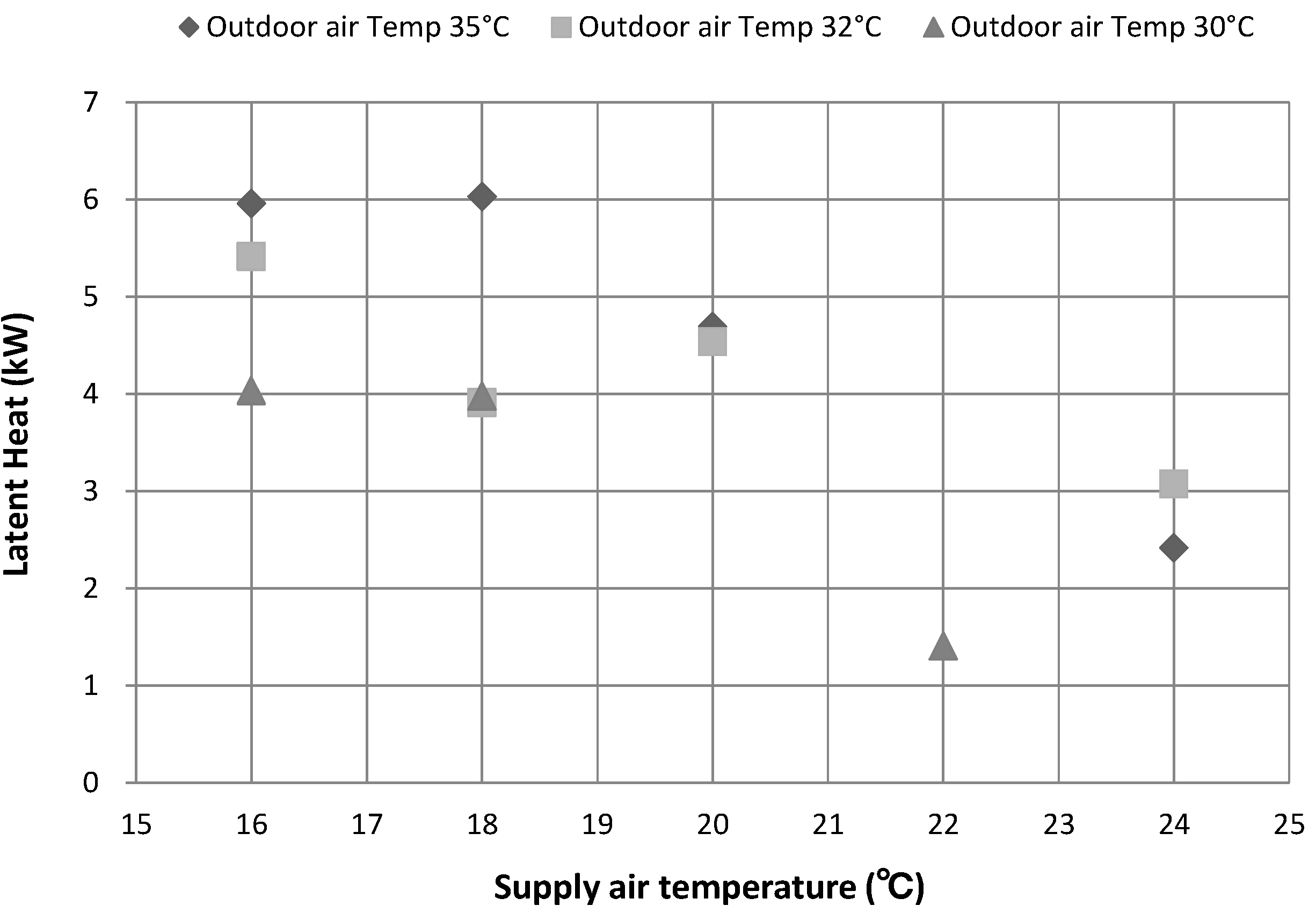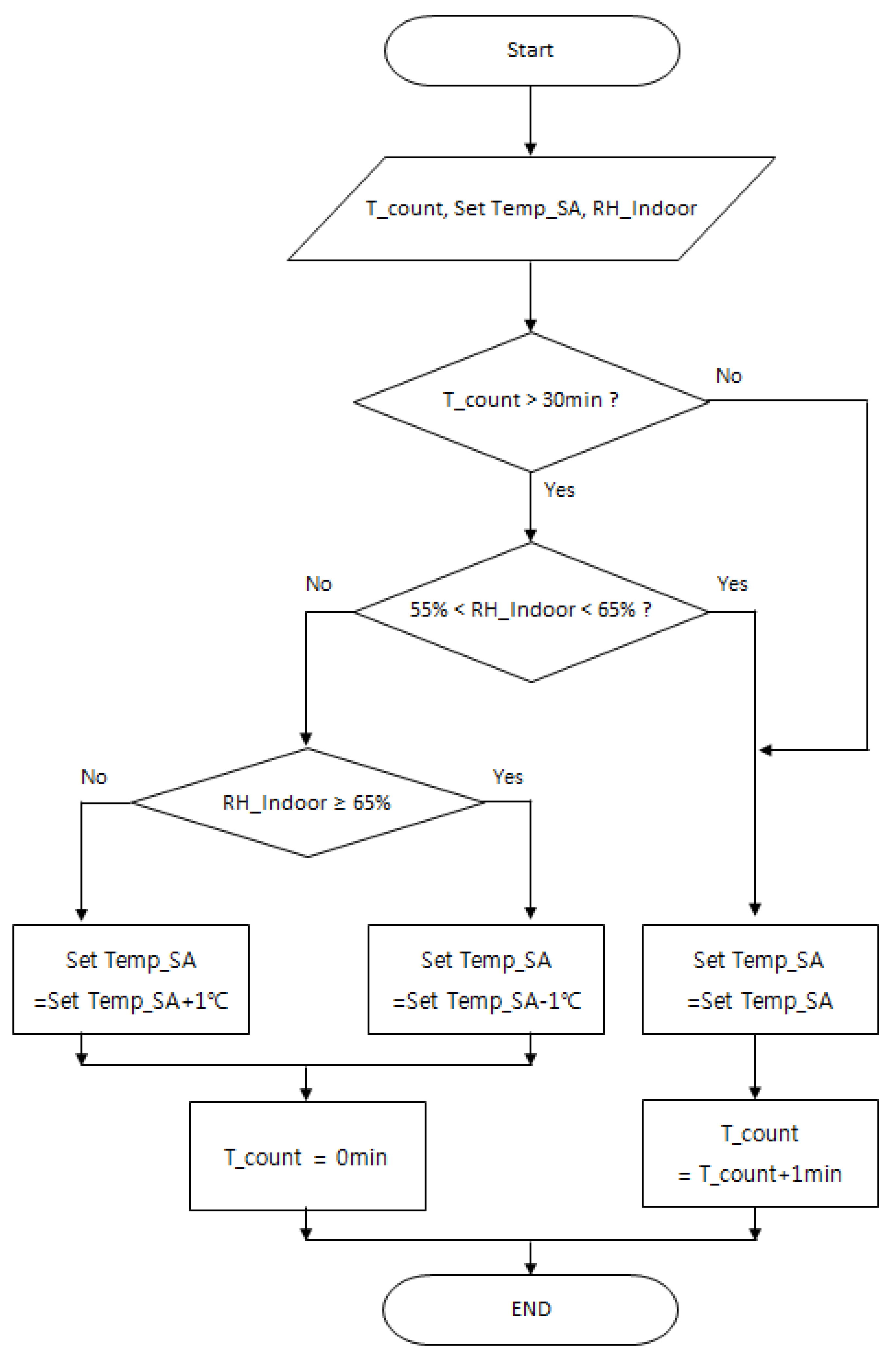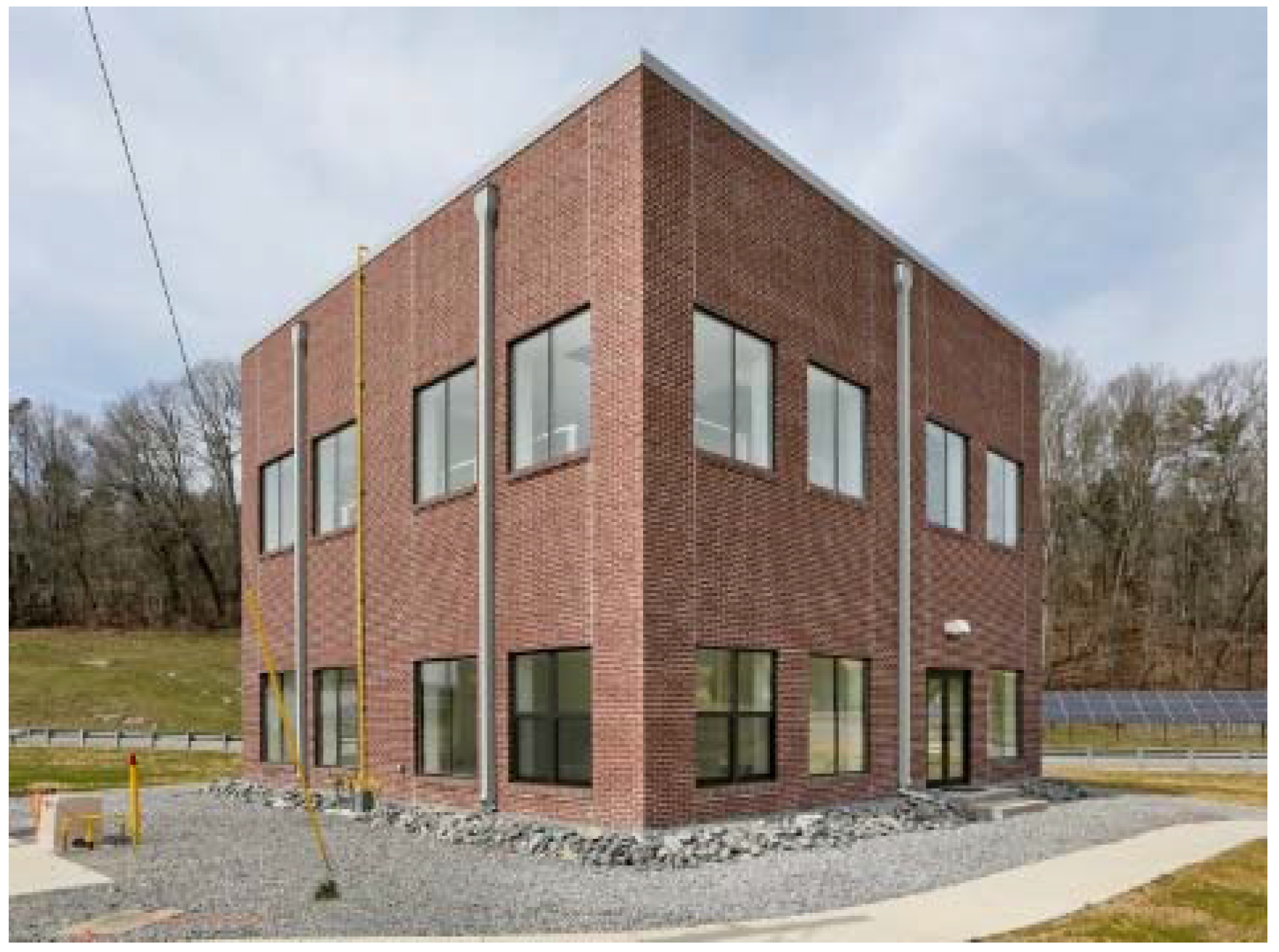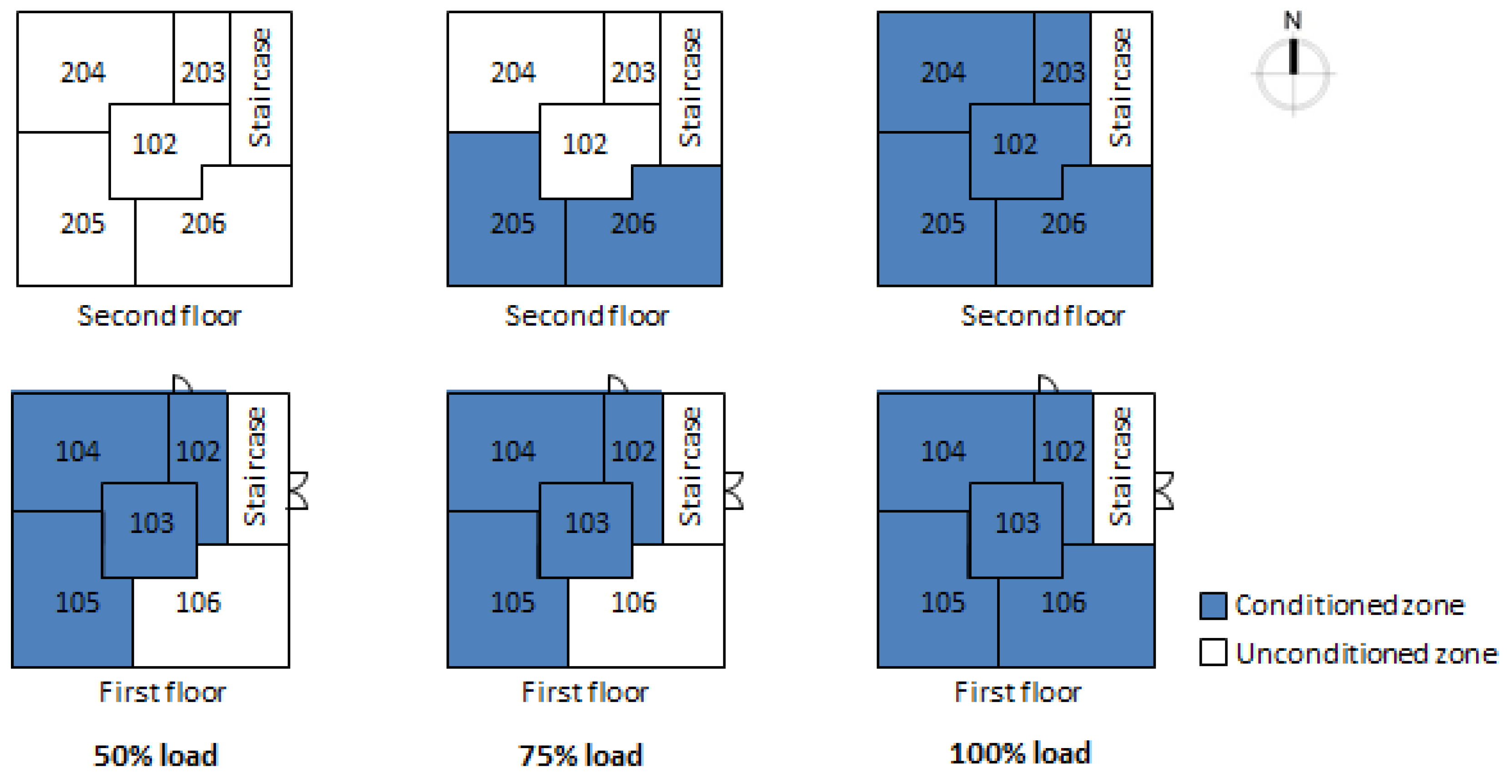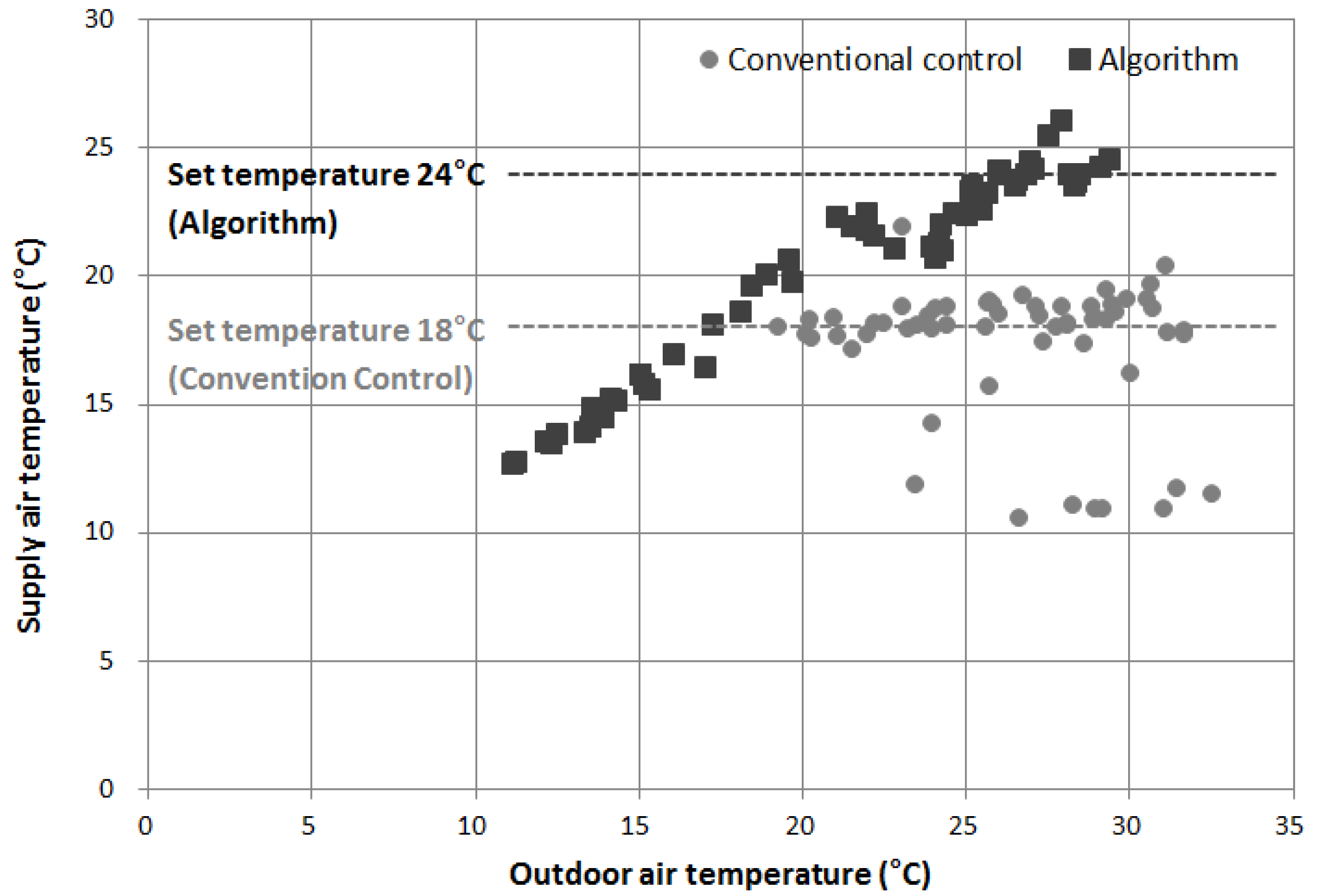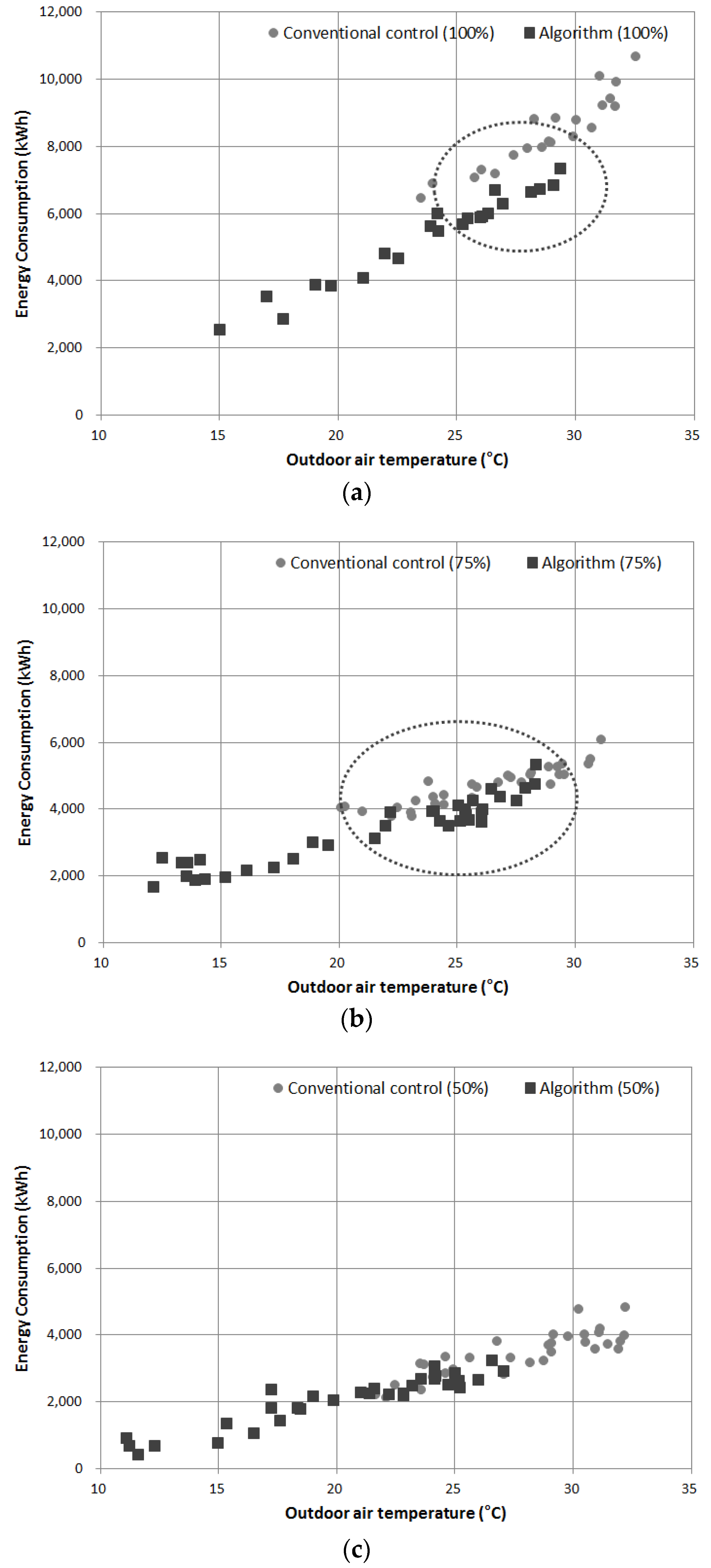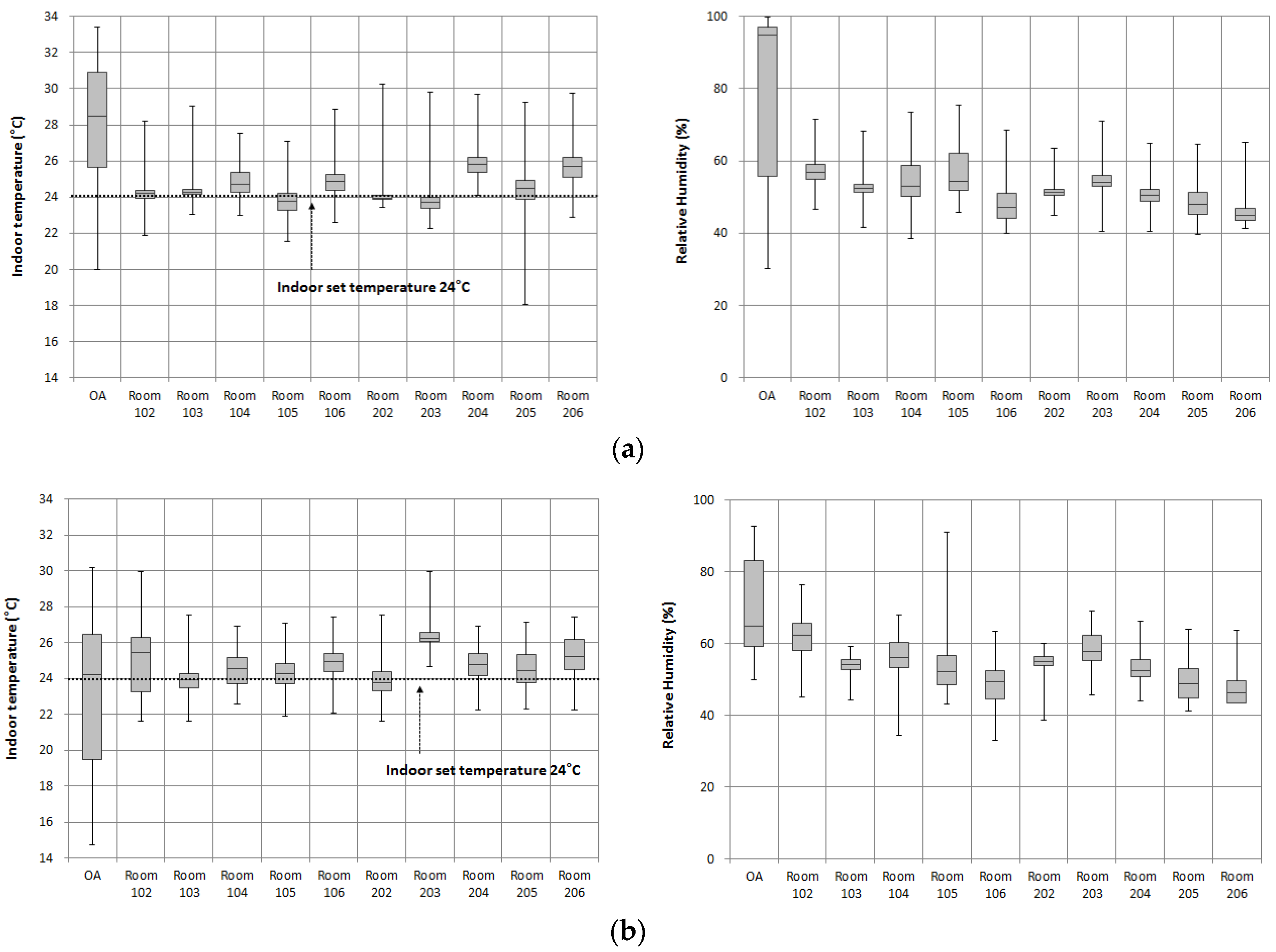1. Introduction
The variable refrigerant flow (VRF) system was developed in Japan in 1982 [
1], and entered the heating, ventilation, and air conditioning (HVAC) market in Europe in 1987 [
2]. Currently, the VRF system market has expanded to China, South Korea, United States, Brazil, Turkey, and India. The market continues to grow, numbering 1.3 million units in 2014 and its market value has reached US
$9.7 billion. The Building Services Research and Information Association (BSRIA) reported that the compound annual growth rate of the VRF system market from 2013 to 2018 will be 11%, and seems to show a substantial growth rate [
3].
The VRF system consists of a single outdoor unit and multiple indoor units. The main components of the outdoor unit are a compressor and a condenser, and those of the indoor unit are evaporators and expansion valves. The outdoor unit and each of the indoor units are connected with the refrigerant pipe, and a refrigerant that is not harmful to the human body, such as R410a, is supplied to the indoor unit directly, thereby processing the indoor heat load at the heat exchanger inside the indoor unit. The VRF system varies the refrigerant flow rate using a variable speed compressor(s) in the outdoor unit, and the electronic expansion valves (EEVs) located in each indoor unit. The system meets the space cooling or heating load requirements by maintaining the zone air temperature at the set-point. The ability to control the refrigerant mass flow rate, according to the cooling and/or heating load enables the use of many indoor units with differing capacities in conjunction with one single outdoor unit. This unlocks the possibility of having individualized comfort control, simultaneous heating and cooling in different zones, and heat recovery from one zone to another. It may also lead to more efficient operations during part-load conditions [
4]. However, regions where the VRF system has been adopted, including the USA, lack the recognition of the benefits of the energy efficiency in the VRF system. Furthermore, additional ventilation equipment is needed in existing VRF systems to complement the ventilation function, and various solutions need to be developed to overcome functional limitations of the VRF system, such as lack of solutions concerning optimal control and integration with other equipment [
5,
6].
Numerous researchers have studied the energy efficiency of the VRF system for many years. Several performance evaluation methods have been proposed for VRF systems: methods using performance indices, such as energy efficiency ratio (EER), coefficient of performance (COP), and seasonal energy efficiency ratio (SEER) [
7,
8], using the measured operational data in field tests [
2,
9], using simulation which is available to evaluate at the same boundary conditions, such as outdoor air condition and internal heating [
10,
11,
12,
13,
14].The performance evaluations through the above methods reported that the VRF system had energy reduction effects of 40% to 60% compared to that of existing central HVAC systems, although there were some difference depending on operational method of the HVAC systems, buildings, and climate. In addition, studies have been conducted on solutions of efficient operation of the VRF system in actual buildings, in which refrigerant evaporation temperature (cooling) and high pressure (heating) were controlled according to load at partial load conditions, thereby reducing the needed energy while maintaining a comfortable indoor thermal environment [
15,
16].
The ventilation solutions in buildings where VRF systems were installed were as follows: Park et al. proposed energy recovery ventilation (ERV) and a dedicated outdoor air system (DOAS) [
17], and Aynur et al. conducted evaluations on indoor thermal environments and energy consumption, while adopting the heat pump desiccant (HPD) [
18,
19,
20]. Zhu et al. introduced a new combination of for HVAC system, as roof top unit (RTU) was used as the OAP in the VRF system, and proposed and evaluated control strategies, energy performance, thermal comfort, and indoor air quality (IAQ) for the system [
21].
Im et al. [
6] adopted the OAP as ventilation equipment for the VRF system. However, in contrast with the OAP, which had additional heat source equipment, including compressors, this study targeted an HVAC system that processed outdoor air loads by supplying refrigerants from the outdoor unit as an outdoor unit in the VRF system. This VRF system was connected to OAP along with multiple indoor units (hereafter referred to as VRF-OAP system) (
Figure 1). In the VRF-OAP system, multiple indoor units and the OAP are connected to a single outdoor unit simultaneously. Thus, controlling the refrigerant flows is more difficult and important than that of the existing VRF system. Furthermore, outdoor air ingested by the OAP is air that is higher or lower in temperature than the indoor temperature. If the thermal load of the outdoor air is not completely processed and introduced to the indoor environment, negative impacts on the comfort of the indoor occupants is much greater than that of the indoor units that process the thermal loads of the indoor air. Because of this, the refrigerant flow control in the VRF-OAP system has been designed to have more flows to the OAP than to the indoor units, and most of the refrigerants inside the system are introduced to the OAP. Thus, the design guide suggests that the OAP capacity should be less than 30% of the outdoor unit capacity to prevent a lack of cooling and heating capacity in other connected indoor units. Im et al. compared the energy consumption and the indoor thermal environments at various partial load conditions with regard to the VRF-OAP system, a conventional roof top unit (RTU), and a variable air volume (VAV) system, thereby proving the superiority of the VRF-OAP system.
This paper developed a control algorithm of the supply air temperature in the OAP as a method to use the VRF-OAP system more efficiently in buildings. The control algorithm of the supply air temperature in the OAP refers to a control that increases the overall energy efficiency in the system, while maintaining a comfortable state in the indoor environment, by adjusting the refrigerant flow introduced to the OAP and the indoor unit appropriately through the supply air temperature control in the OAP, according to the indoor and outdoor temperature and humidity conditions during cooling operations. In this paper, changes in processing of sensible and latent heat in the VRF-OAP system and energy efficiency were investigated according to the supply air temperature through multicalorimeter experiments first, and then the control algorithm of the supply air temperature in the OAP was developed based on the investigation results. Furthermore, the algorithm was mounted to the VRF-OAP system installed in the test building to verify the algorithm effects in a real building.
3. Development of Supply Air Temperature Control Algorithm for VRF-OAP System
The results of the multicalorimeter experiment verified that the system efficiency was improved as the supply air temperature in the VRF-OAP system was increased. In addition, the reduction in overall cooling capacity in the system was not exhibited according to the supply air temperature, which indicated that there would be no significant effect on the indoor temperature through the control of the supply air temperature. However, when the supply air temperature was higher than the dew point temperature of the outdoor air, it would cause an increase in the indoor humidity as a result of the reduction in the latent heat processing amount. Thus, this study developed a control algorithm for the supply air temperature that improved the overall efficiency of the system by setting the supply air temperature as much as possible, while maintaining the indoor relative humidity within the range of comfort.
Figure 5 shows the flow chart of the control algorithm. The input data in the control algorithm were the elapsed time (T_count) after changing the supply air temperature, the current set value of the supply air temperature (Set Temp_SA), and the indoor relative humidity (RH_indoor). A control range of the supply air temperature was 13–24 °C, and the initial set value was 18 °C. First, whether the T_count exceeded 30 min. was determined. If it did not exceed 30 min, the current set value of the supply air temperature was maintained and one min was added to the T_count followed by termination. If the T_count exceeded 30 min, Set Temp_SA was determined according to the RH_indoor. Here, 30 min. of the T_count was determined considering the time for the supply air temperature to reach the set value after changing the set value of the supply air temperature and a waiting time of for an improvement of the system efficiency due to the change in the supply air temperature. If RH_indoor was within 60 ± 5%, which was a comfort range, Set Temp_SA was maintained without change, if it was above 65%, “Set Temp_SA was lowered by 1 °C”, and if it was below 55%, “Set Temp_SA was raised by 1 °C” was applied. If Set Temp_SA was changed, the T_count was reset to 0 min, and if it was maintained, one min. was added to the T_count and the algorithm terminated. The control algorithm was run continuously once every min.
5. Conclusions
This paper developed the control algorithm for the supply air temperature in the OAP for VRF-OAP systems, and verified the effects by applying the algorithm to a test building. To develop the control algorithm, the cooling capability of the VRF-OAP system and changes in efficiency according to the supply air temperature were experimented using a multicalorimeter. With the increase in the supply air temperature, the cooling capacity of the OAP was decreased, but the overall cooling capability in the system was nearly the same, as the cooling capability of the indoor unit increased. This study result verified that the latent heat processing amount rapidly decreased at a supply air temperature which was higher than the dew point temperature of the outdoor air. The system EER was improved at outdoor air temperatures of 32 °C and 30 °C as the supply air temperature increased, resulting in about 11% at an outdoor air temperature of 32 °C and approximately a 9% improvement at an outdoor temperature of 30 °C; the supply air temperature was set to 24 °C compared to the system EER at 16 °C. Based on the above results, the control algorithm that improved system efficiency was developed by raising the supply air temperature as much as possible within a range where the indoor relative humidity did not affect the comfort of occupants. The algorithm was mounted on the test building, in which the indoor load was controlled by portable heaters and humidifiers and the effects of the algorithm were verified under various load conditions (100% load, 75% load, and 50% load). The field test results exhibited the effects of energy reduction are higher at 100% load than 75% load at the same temperature. At the same load, higher reduction effects were revealed when the outdoor air temperature was lower. However, this field test did not collect sufficient data to verify the algorithm effects, as the demonstration period was too short for each control. For future studies, the algorithm effects should be verified through a long-term demonstration period.


